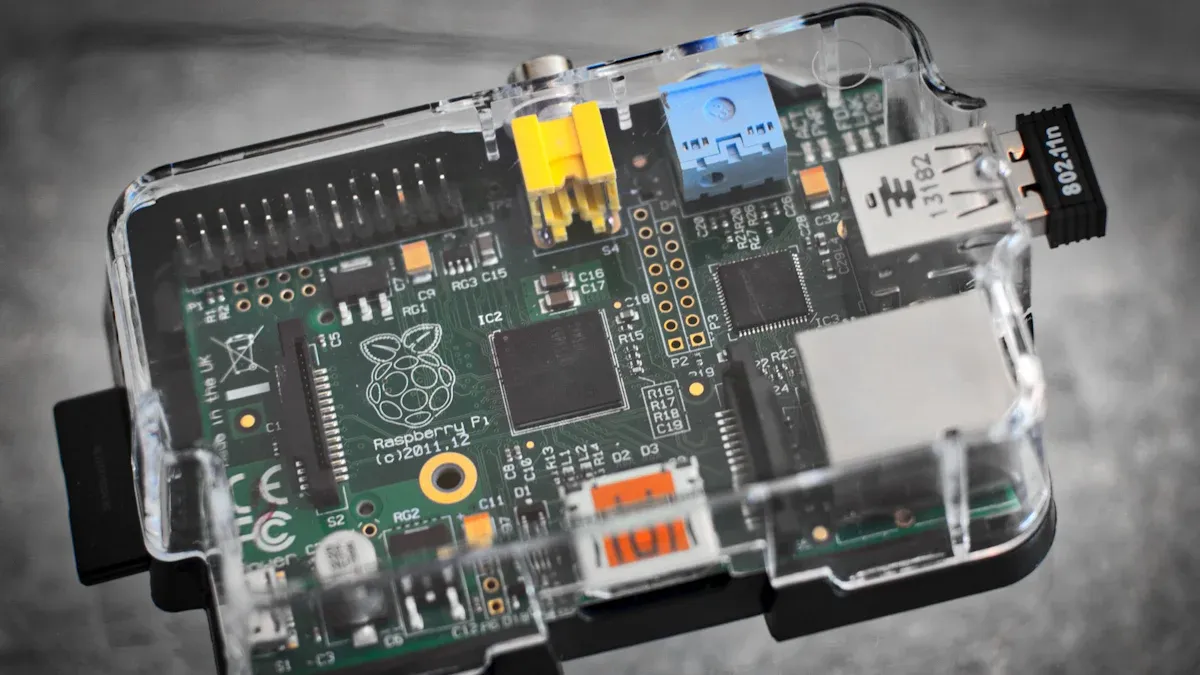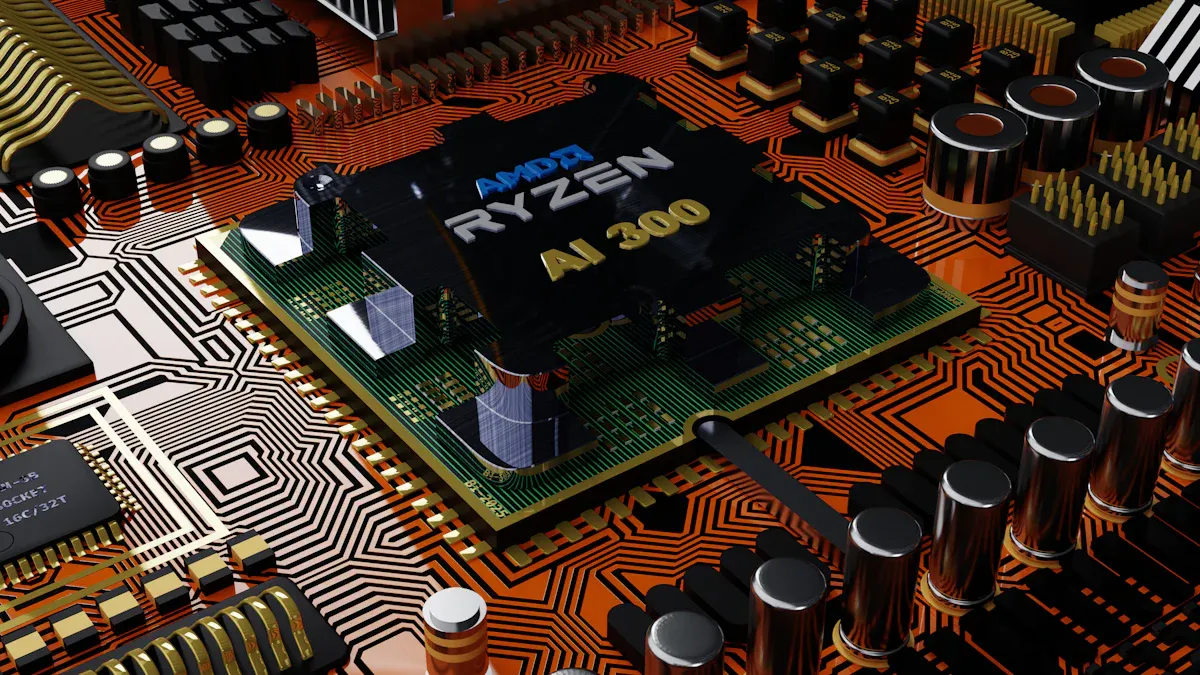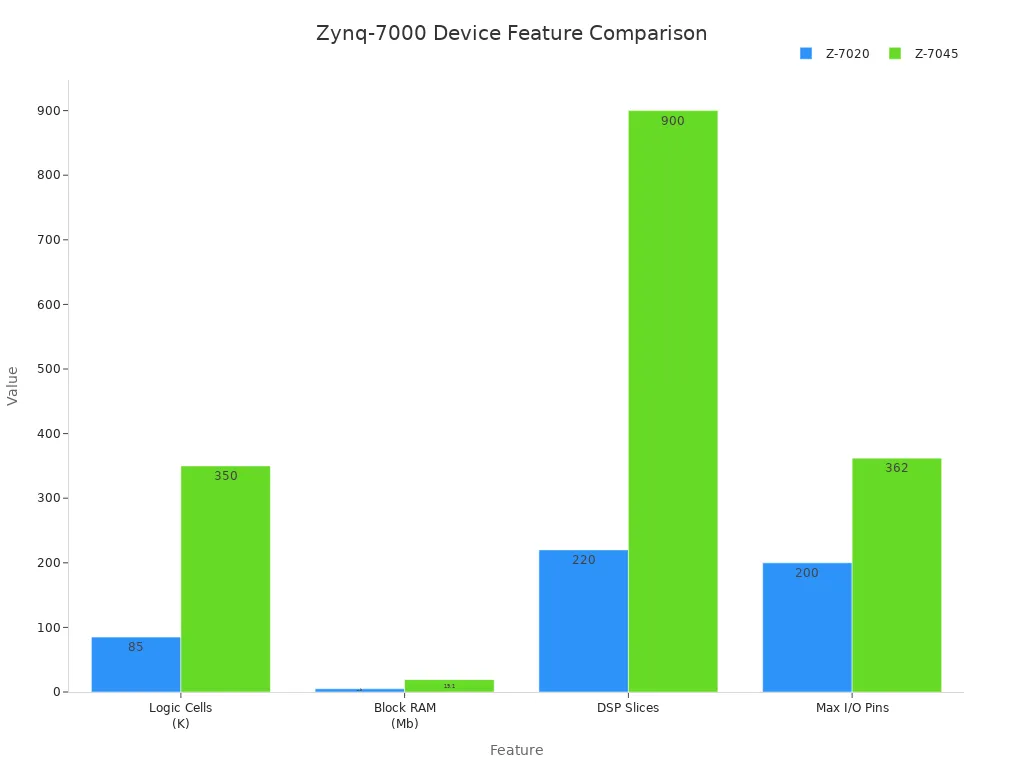XC7Z020-2CLG400I: Your Zynq-7000 SoC Selection Solved

Embedded system designs grow increasingly complex. Selecting the right System-on-Chip (SoC) is crucial for success. The embedded systems market is expanding rapidly; experts project a Compound Annual Growth Rate (CAGR) of around 4.77% between 2025 and 2034. The Zynq-7000 family offers powerful ARM processor and FPGA integration. The XC7Z020-2CLG400I stands out. It provides balanced features and cost-effectiveness for many designs in 2025. This blog helps you understand why this specific part is often optimal. You will learn how to confirm it fits your unique project requirements.
Key Takeaways
The XC7Z020-2CLG400I chip is a great choice for many projects. It has a strong processor and flexible hardware.
This chip offers good power for its price. It is also easy to find and buy.
You can use this chip for many things. These include robots, factory controls, and medical devices.
Always check your project's needs. Make sure the chip's features match what you want to do.
Start your project with development boards like PYNQ-Z2. Use AMD Vivado and Vitis software tools.
Why the XC7Z020-2CLG400I Stands Out

The XC7Z020-2CLG400I is a strong contender for your embedded system designs in 2025. It offers a compelling mix of features that make it highly relevant and advantageous. You get a powerful solution without unnecessary complexity or cost.
Balanced Processing Power: Dual-Core ARM Cortex-A9
You need a processor that can handle your software tasks efficiently. The XC7Z020-2CLG400I features a dual-core ARM Cortex-A9 processor. This processor provides excellent performance for operating systems, complex algorithms, and user interfaces. It allows you to run your applications smoothly. The dual cores mean you can handle multiple tasks at once, improving your system's responsiveness. This balanced processing power is often exactly what embedded applications require.
FPGA Fabric Versatility: 85K Logic Cells
Beyond the ARM cores, you gain significant flexibility with the integrated FPGA fabric. The XC7Z020-2CLG400I includes an Artix™-7 FPGA. This FPGA comes with 85,000 logic cells and 256KB of RAM. You also have 6,650 Logic Array Blocks (LABs) at your disposal. This rich fabric allows you to implement custom hardware accelerators. You can create specialized interfaces or perform parallel processing tasks. This capability is crucial for many modern embedded systems.
Consider these common applications that effectively use the 85K logic cells:
Flow Sensors
POS Terminals
Deep learning hardware
Digital Signal Processing
Industrial automation controllers & motor drives
Embedded vision systems & medical imaging
Communications infrastructure & network processing
Automotive ADAS & infotainment systems
Aerospace & defense embedded computing
You can see how this versatility opens up many design possibilities.
Cost-Effectiveness and Availability
When you choose components, cost and availability are always important. The XC7Z020-2CLG400I offers a very attractive price point. It is listed at a price of $17.17. This makes it a cost-effective choice for many projects. You will also find good stock levels. Currently, 15,257 units are in stock.
Lead times are also favorable for this part.
Quantity (pieces) | Lead time (days) |
|---|---|
1 - 100000 | 7 |
> 100000 | To be negotiated |
For example, HamGeek lists 2,000 units in stock for a product using this chip. While SemiBing.com requires an inquiry for specific availability, the general trend shows good access. This strong availability helps you avoid delays in your production schedule.
Power Efficiency for Embedded Applications
Embedded systems often operate in environments where power consumption is a critical factor. You might design battery-powered devices or systems with strict thermal budgets. The Zynq-7000 architecture, and specifically the XC7Z020-2CLG400I, is designed with power efficiency in mind. It allows you to achieve high performance without drawing excessive power. This helps you extend battery life and reduce cooling requirements for your products. You can build compact and reliable systems.
Key Zynq-7000 Design Considerations
You must carefully evaluate your project's needs when choosing any Zynq-7000 SoC. This helps you pick the best part for your design. Consider these important factors.
Performance: CPU, FPGA, and Memory
You need to match the SoC's performance to your application. Think about the CPU speed for software tasks. Also, consider the FPGA logic for hardware acceleration. Memory bandwidth is very important. The Zynq-7000's dynamic memory controller supports DDR3, DDR3L, DDR2, and LPDDR2. It can operate in 16-bit or 32-bit modes. This gives you access to a 1 GB address space. When you use DDR3, you can reach a maximum speed of 1333 Mb/s. The DDR controller can operate up to 533 MHz and supports DDR3-1066. You can achieve a total bandwidth of about 3291 MB/s with certain settings. Some setups even show 3577.4 MB/sec, which is close to the theoretical maximum of 4096 MB/sec.
I/O and Peripheral Needs
Your system needs to talk to other devices. You must list all the input/output (I/O) and peripheral interfaces you require. The Zynq-7000 series supports many common interfaces. These include:
Ethernet (including Gigabit Ethernet)
USB
CAN
SPI
I2C
UART
SATA
PCIe
You can also create custom interfaces directly in the FPGA. This is useful for specialized or older hardware.
Power Budget and Thermal Management
You must consider how much power your system will use. This is especially true for battery-powered devices. You also need to manage the heat the chip produces. A good design ensures your system stays cool and reliable.
Project Cost Constraints
Cost is always a factor in your project. You need to balance features with your budget. Zynq-7000 development boards typically cost from about $115 to over $500. The price changes based on features. AMD offers the Vivado Design Suite with a free WebPACK edition. This helps reduce software costs for your Zynq projects.
Development Ecosystem and Tool Support
You need good tools to develop your project. The AMD Vivado Design Suite supports Zynq-7000 development. The free WebPACK edition works with boards like the Arty Z7. Vivado offers High-Level Synthesis (HLS). This lets you write designs in C, C++, or SystemC. It also has an IP Integrator for easy assembly of IP cores. Machine learning-driven optimizations improve design performance. Vivado provides a unified design environment. This streamlines your workflow. Remember, AMD software tools are not available for download in some countries. You should check this before buying hardware.
Is the XC7Z020-2CLG400I Right for You?
You have learned about the XC7Z020-2CLG400I's features. Now, you need to decide if it fits your project. This section helps you make that choice. You will see when this chip is perfect and when you might need something else.
Use Cases for XC7Z020-2CLG400I
The XC7Z020-2CLG400I is a great choice for many embedded applications. Its balance of ARM processing and FPGA logic makes it very versatile. You can use it in systems that need both software intelligence and hardware acceleration.
Consider these ideal applications:
Industrial Control: You can manage complex machinery. The chip handles real-time data and precise control.
Robotics: Robotics applications demand specific performance. This chip provides:
High-speed processing
Real-time data management
Diverse automation tasks
Advanced control systems You can build robots that respond quickly and accurately.
Vision Systems: You can process images and video streams. The FPGA accelerates tasks like filtering and object detection.
Medical Devices: You can develop devices needing reliable processing and custom interfaces.
Test and Measurement: You can create flexible instruments. They can adapt to different testing needs.
This chip offers enough power and flexibility for these and many other mid-range embedded projects.
When to Consider Higher-End Zynq-7000
Sometimes, your project needs more power than the XC7Z020-2CLG400I offers. You might work with very demanding applications. These often involve extensive data processing or many high-speed interfaces.
For example, if you are doing complex image processing or high-bandwidth networking, you might need a higher-end Zynq-7000 device like the Zynq-7045. These chips offer significantly more resources.
You can see the difference in resources:
Feature | Z-7020 | Z-7045 |
|---|---|---|
Logic Cells (K) | 85 | 350 |
Block RAM (Mb) | 4.9 | 19.1 |
DSP Slices | 220 | 900 |
Max I/O Pins | 200 | 362 |
Max Transceiver Count | - | 16 |

A Zynq-7045 gives you four times the logic cells and block RAM. It also has many more DSP slices. These extra resources are vital for applications like 4K video processing or advanced radar systems. You gain more I/O pins and high-speed transceivers. This allows for faster data transfer and more complex system integration.
When to Consider Lower-End Zynq-7000
You might find that the XC7Z020-2CLG400I is more than you need. Some projects have simpler requirements. You can save costs and power by choosing a smaller Zynq-7000 chip.
For instance, a Zynq-7010 is a good option for less demanding tasks. It uses less power. You can use a lower current 1.0V buck converter, specifically one that provides up to 3A. This is enough for the Zynq-7010. The XC7Z020-2CLG400I (Zynq-7020) would need a higher current buck converter. If your power budget is very tight or your logic needs are minimal, a Zynq-7010 could be a better fit.
Checklist: Matching Requirements to XC7Z020-2CLG400I Specs
Use this checklist to see if the XC7Z020-2CLG400I meets your project's needs:
Processing Power: Do you need a dual-core ARM Cortex-A9 for your operating system and application code?
FPGA Logic: Do your custom hardware accelerators or parallel processing tasks fit within 85,000 logic cells and 256KB of RAM?
I/O Requirements: Do the available I/O pins and peripheral options (Ethernet, USB, SPI, etc.) cover all your connectivity needs?
Memory: Is 1GB of DDR3-1066 memory sufficient for your data storage and processing?
Power and Thermal: Can your system accommodate the power consumption? The XC7Z020-2CLG400I has an operating temperature range of -40℃ to 100℃ (TJ). For -2LI devices, the programmable logic (PL) VCCINT/VCCBRAM operates at 0.95V. You should ensure your design respects these limits.
Cost: Does the price point of the XC7Z020-2CLG400I fit within your project budget?
Availability: Is the current stock and lead time acceptable for your production schedule?
If you answer "yes" to most of these questions, the XC7Z020-2CLG400I is likely an excellent choice for your design.
Getting Started with the XC7Z020-2CLG400I

You have decided the XC7Z020-2CLG400I is the right fit for your project. Now, you need to begin your development. This section guides you through the practical next steps. You will learn about recommended hardware, essential software, and helpful community resources.
Recommended Development Boards
You need a good development board to start working with your Zynq SoC. These boards provide a ready-to-use platform.
The PYNQ-Z2 board is an excellent choice. It helps you get started with PYNQ. This board is low-cost. It suits both beginners and advanced projects. The PYNQ-Z2 features the Zynq Z7020 device. It uses the Xilinx Zynq XC7Z020 System on Chip (SoC). You can program it in Python. You do not need to design complex logic circuits.
The ZedBoard is another popular option. It offers great value.
The ZC702 Evaluation Kit is a powerful alternative. It has enhanced I/O capabilities.
Feature | ZedBoard | ZC702 |
|---|---|---|
Overall Nature | Versatile | Powerful |
Price | $395 | $895 |
Processor | XC7Z020-CLG484-1 | XC7Z020-CLG484-1 |
DDR3 Memory | 512 MB | 1 GB |
FMC Connectors | 1 LPC | 2 LPC |
Ethernet | 10/100/1000 | Gigabit Ethernet (GMII, RGMII, SGMII) |
Video Output | HDMI 1080P + VGA | HDMI Video OUT |
The ZC702 offers more I/O options. It has two LPC FMC connectors. This allows for more data input and output.
Essential Software Tools
You need specific software to develop your Zynq project.
The AMD Vitis software platform helps you create software applications. It supports both standalone and Linux-based applications. Vitis helps with platform creation, design creation, application debug, profiling, boot image creation, and flash programming.
You can also use PetaLinux for embedded Linux applications.
Community Resources and Support
You are not alone in your Zynq development journey. Many resources can help you.
The PYNQ forum is a great place for questions. It focuses on the PYNQ open-source project. This project uses Zynq SoCs.
AMD provides official documentation. Look for "AMD Board File Documentation." You can also find 'ug585-zynq-7000-SoC-TRM' on the AMD Technical Information Portal. This document has technical reference material for the Zynq-7000 family.
You can see the active support in Zynq-7000 developer forums:
This chart shows that support topics are very common. This means you will find help when you need it.
You now understand why the XC7Z020-2CLG400I is a highly versatile Zynq-7000 SoC. It offers optimal performance for many embedded system designs in 2025. You explored its key benefits:
Balanced processing power
Flexible FPGA fabric
Cost-effectiveness
Always evaluate your unique project needs. Use this guide to confidently select the right Zynq-7000 variant for you. The Zynq-7000 platform continues to empower innovative embedded solutions.
FAQ
What is the main advantage of Zynq-7000 SoCs?
You get the best of both worlds. Zynq-7000 SoCs combine a powerful ARM processor with a flexible FPGA fabric. This allows you to run complex software and implement custom hardware acceleration on one chip. It simplifies your design.
Why should I choose the XC7Z020-2CLG400I for my project?
You should choose it for its excellent balance. It offers dual-core ARM processing and a capable FPGA. This chip is cost-effective and readily available. It suits many mid-range embedded applications perfectly.
Can I use the XC7Z020-2CLG400I for AI/ML applications?
Yes, you can. The FPGA fabric allows you to implement custom accelerators for machine learning tasks. You can offload computationally intensive parts of your AI algorithms to the hardware. This improves performance significantly.
What software tools do I need to start developing with the XC7Z020-2CLG400I?
You will need the AMD Vivado Design Suite for FPGA development. For software, use the AMD Vitis software platform. If you plan to run Linux, PetaLinux is your tool. These tools help you create your entire system.
See Also
Evaluating Leading FPGA Development Boards: A Comprehensive Manufacturer Comparison
The 10 Best Microcontrollers for Embedded Systems Projects in 2025
Selecting the Ideal Low-Power MCU for Your Specific Project Needs
Replacing the WQFN40 Switch Chip in Your Nintendo Switch Console
Understanding Hotswap Controller Chips: Functionality and Operational Principles Explained
